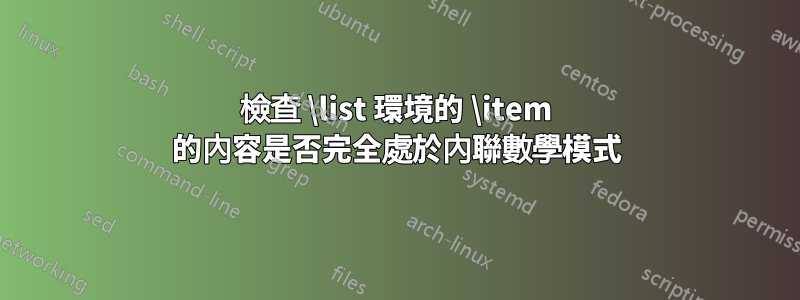
我有一個清單
\begin{list}{}{}
\item[(1)] First things first.
\item[(2)] There are \(1 + 1 = 2\) types of "normal" math
\[e^{2\pi i} + 1 = 2\]
\item[(3)] Third time's \(\frac{1}{3}\) of a charm.
\item[(4)] \(f(x) = 4\)
\end{list}
我只想將以下命令應用於 (4):
\newcommand{\displayit}[1]{\bgroup\allmath{\displaystyle}#1\egroup}
這裡的條件是,(4) 發生的唯一事情是它包含內聯數學材料——除指令之外沒有其他內容\item。相反,(1) 不包含數學; (2) 同時包含內聯數學和顯示數學,而「真正的」內聯數學材料位於句子的中間; (3) 與 (2) 的情況類似,在句子中間有「真正的」內聯數學。
我不能只是將 (2) 代入,\[1 + 1 = 2\]因為這會產生不需要的格式(例如方程式周圍有更多的空白)。
答案1
前面的評論:我建議您加載包並鍵入,而不是使用非常低級別的list環境,然後必須手動編輯每個標籤的外觀- 不再手動編輯每個標籤的輸出每一項指令。\itemenumitem\begin{enumerate}[label=(\arabic*)] ... \end{enumerate}\item
雖然 OP 表示不想使用 LuaLaTeX,但這篇文章的其他讀者可能會發現看到基於 LuaLaTeX 的解決方案很有啟發性。以下輸入格式要求希望不具約束力:
\begin{enumerate},\item, 並且\end{enumerate}永遠不會發生一起在輸入行中;\item每個輸入行至多有一個指令;- 輸入行中至多有一個內聯數學材料的實例;和
\(和\)用於啟動和終止內聯數學模式。
此解決方案的工作原理如下:一個名為 的 Lua 函數switch2displaystyle對每一行輸入進行操作;如果它在enumerate環境中,它會檢查輸入行是否包含\item(可選)和純內聯數學材料(即沒有文字)。如果滿足此條件,則\displaystyle在 後插入指令\(。此switch2displaystyle函數使用 Lua 的find、sub和gsubstring 函數。
還有兩個實用的 LaTeX 宏,稱為\DisplayOn和\DisplayOff,可以啟動和停用該switch2displaystyle功能。我所說的「激活」是指分配switch2displaystyle給 LuaTeX 的process_input_buffer回調,其中該函數作為輸入流上的預處理器運行。
% !TEX TS-program = lualatex
\documentclass{article}
\usepackage{enumitem}
\usepackage{luacode} % for 'luacode' envenvironment
\begin{luacode}
in_list_env = false -- initiate a Boolean flag
function switch2displaystyle ( s )
if s:find ( "\\begin{enumerate}" ) then
in_list_env = true
elseif s:find ( "\\end{enumerate}" ) then
in_list_env = false
elseif in_list_env == true then -- there's something to do
if s:find ( "\\item" ) then
s = s:gsub ( "^%s-\\item%s-(\\%(.-\\%))$" ,
function ( x )
return "\\item \\( \\displaystyle " .. x:sub(3)
end )
else
s = s:gsub ( "^%s-(\\%(.-\\%))$" ,
function ( x )
return "\\( \\displaystyle " .. x:sub(3)
end )
end
return s
end
end
\end{luacode}
% Define 2 LaTeX utility macros
\newcommand\DisplayOn{\directlua{%
luatexbase.add_to_callback(
"process_input_buffer" , switch2displaystyle ,
"switchtodisplaystyle" )}}
\newcommand\DisplayOff{\directlua{%
luatexbase.remove_from_callback(
"process_input_buffer" ,
"switchtodisplaystyle" )}}
\begin{document}
\DisplayOn % activate the Lua function
% Verify that nothing happens if we're not in an 'enumerate' env.
\( \frac{1}{2}+\frac{1}{2}=1 \)
\begin{enumerate}[label=(\arabic*)]
\item First things first.
\item There are \( \frac{2}{2}+\frac{3}{3}=2 \) types of ``normal'' math
\[ \textstyle \frac{1}{2}+\frac{1}{2}=1 \]
\item Third time's \( \frac{1}{2}+\frac{1}{2}=1 \) not a charm.
\item \( \frac{1}{2}+\frac{1}{2}=1 \)
\( \frac{1}{4}+\frac{1}{4}=\frac{1}{2} \)
\DisplayOff % deactivate the Lua function
\(\frac{1}{2}+\frac{1}{2}=1\)
\end{enumerate}
\end{document}



